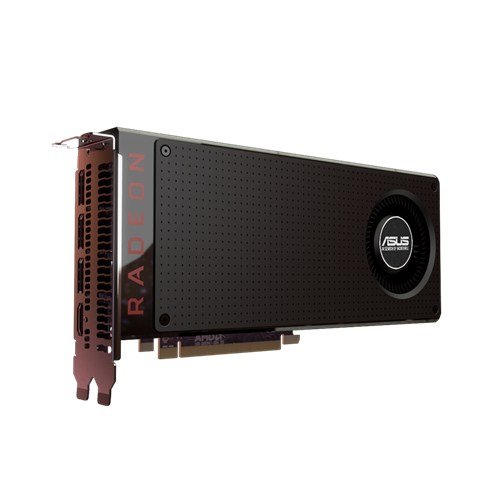The season of graphics card releases is in full swing. So far, Nvidia has dropped the ridiculously powerful GeForce GTX 1080 and the still-incredibly-powerful GTX 1070 followed a couple weeks later. Now AMD has thrown is hat into the mix by releasing the Radeon RX 480.
The RX 480 isn’t meant to compete with the big dogs that Nvidia just released. Instead, AMD is targeting the value market with its latest offering. In the US, the 4GB variant of the card starts at $200, and the 8GB version (the only one you can get right now) is priced at $240. The price of the 4GB version hasn’t been released for Canada yet, but we can pick up the 8GB RX 480 for $329. That doesn’t sound like a super cheap card until you realize where this thing stacks up in the performance lineup.
AMD has targeted VR as the benchmark target for this card. Previously, if you wanted to have a VR-ready PC, you had to shell out for an R9 390 or a GTX 970, both of which were selling for north of $500 just of a month ago, and they are still trading around the $400 mark. The RX 480 was designed to deliver similar performance to the R9 390, but at a much cheaper price. The idea being, AMD wants to dominate the entry level VR market.
Early reviews are showing that AMD has managed to deliver the performance it promised, but you should still steer clear of the RX 480, at least for the time being.
You see, AMD also made claims about the power draw of the card. Specifically, it set the power target of the card at 150w TDP. This is an incredible feat for an AMD card. Radeon GPU has traditionally been extremely power hungry. It was not unlikely to see an R9 390 pull closeto 400w of power.
Sure enough, the 150w TDP ended up being too good to be true. Tom’s Hardware and PCPerspective both did advanced power draw tests that isolated how much power was being drawn from the PCIE slot and the PCIE power plug. It turns out, the RX 480 actually draws closer to 165w when it’s being stressed. That wouldn’t be a problem if the card was equipped with enough external power plugs, but AMD’s reference card calls for a single 6-pin power connection that is only able to deliver 75w. The rest of the power ends up coming through the PCIE slot, which is causing issues.
The PCIE standard allows for up to 75w of power through the slot. The RX 480, however, has been shown to draw as much as 90w through the motherboard. This can cause all sorts of potential issues with your system, from affecting onboard audio controllers to rebooting your system randomly. It could even potentially blow components on your motherboard. There have been unconfirmed reports of that happening to a few people already.
This is a big problem for AMD and one that it has to address quickly. The company is in serious need of a win with the RX 480 and other Polaris-based GPU offerings it releases this year. AMD has been struggling for many years and a flop here could be disastrous for the company. Fortunately, AMD is not taking this lightly. The company issued a statement on Saturday saying that it is working on a solution and will have more to share on Tuesday after the holiday weekend.
“As you know, we continuously tune our GPUs in order to maximize their performance within their given power envelopes and the speed of the memory interface, which in this case is an unprecedented 8Gbps for GDDR5. Recently, we identified select scenarios where the tuning of some RX 480 boards was not optimal. Fortunately, we can adjust the GPU’s tuning via software in order to resolve this issue. We are already testing a driver that implements a fix, and we will provide an update to the community on our progress on Tuesday (July 5, 2016).” — AMD
AMD did say that it could fix the problem with a software update, but I can’t imagine that will have positive effects on the cards performance. If AMD has to dramatically reduce the clock speed of the GPU in order to stay within power draw specifications, it runs the risk of dipping below that coveted minimum VR performance threshold. If that happens, AMD’s whole marketing plan for this card will have fallen flat on its face.
Until we see how this whole situation blows over, I can’t in good conscience recommend buying an RX 480. Wait it out a week or two and see how the updated drivers affect the performance and power draw of the card. I have a feeling AMD is going to have to scrap the reference design and rely on add-in board partners to release cards with additional power plugs to keep the PCIE slot within spec.
This is especially unfortunate for AMD because the GTX 1060 should be just around the corner. We don’t have a release date or official specs yet, but leaks have started to happen, which usually means we’ll hear some real news in the coming days.
AMD really can’t afford a misstep like this right now.
Kevin Carbotte is Senior Editor, Hardware for AYBOnline.com. He knows a little about a lot, and a lot about a little. The opinions in his columns are his and his alone, but you are free to have them.


